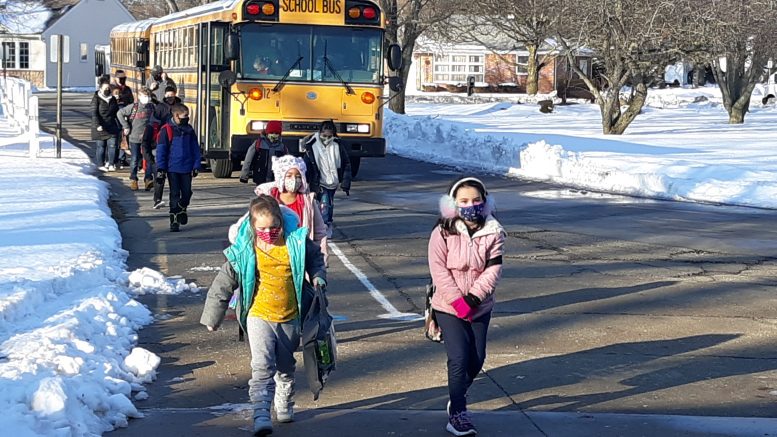BY SUSAN TEBBEN
Coming alongside renewed calls from the CDC for mask wearing, even by the vaccinated, the Ohio Department of Health laid out ways in which K-12 schools should be preventing COVID-19 in the upcoming school year.
With no requirement for masks included in the recommendations, announced on Monday, the Ohio Department of Health is counting on partnerships with local health departments, awareness of the science of COVID-19 and promotion of the vaccine as strategies to keep spread of the pandemic out of schools this fall.
Vaccination is emphasized in the guidance as “the leading public health prevention strategy to end the COVID-19 pandemic.”
“Achieving high levels of COVID-19 vaccination among eligible students as well as teachers, staff and household members is one of the most critical strategies to help schools safely conduct in-person learning and allow safe participation in extracurricular activities and sports,” the ODH stated in the recommendations.
Children younger than 12 still don’t have that level of protection against COVID-19, which obligates adults and children older than 12 to vaccinate to protect everyone, according to pediatricians who joined ODH Chief Medical Officer Dr. Bruce Vanderhoff in announcing the guidance earlier this week.
COVID-19 vaccinations, like masks, won’t be required by the state, but the ODH gave school districts strategies to promote vaccination, including considering pop-up clinics in conjunction with school activities, offering flexible sick leave options for employees to get vaccinated or excused absences for students to get their shot, and offering vaccinations as part of summer medical physicals and other immunizations.
The state requires other immunizations, such as diptheria, tetanus, pertussis (DTaP); measles, mumps, rubella (MMR), and varicella (chickenpox), to attend school.
Ohio Revised Code has said since 2015 that no student can stay in school for more than 14 days “unless the pupil presents written evidence” of their immunization. If a student isn’t immunized, a parent can provide a statement saying they can’t be immunized for religious reasons or “reasons of conscience,” or a physician’s statement that the immunization isn’t medically recommended.
The guidance for the upcoming school year recommends unvaccinated individuals wear masks while indoors and in crowded settings “where physical distancing cannot be maintained.”
For those districts not opting to require masks, parents will still have the option to have their children wear masks while in school or participating in school activities.
– ODH guidance on K-12 schools
The health department said mask use is not necessary outdoors, however, they acknowledge the CDC recommendation that in areas of substantial-to-high transmission, unvaccinated people should wear a mask in crowded outdoor settings.
The CDC just announced an update to their mask recommendations, saying new evidence shows even the vaccinated could be carriers of enough of the virus to infect others, and therefore should return to wearing masks in public indoor spaces.
A spokesperson for the ODH said the department would “await any revised recommendations from the CDC and review them at that time.”
School buses and public transportation still require mask-wearing per the CDC, the state health department said, regardless of vaccination status.
Because of layered health protection strategies like vaccination and mask-wearing, the state is not recommending that unvaccinated students who have been exposed to COVID-19 in school setting quarantine or isolate, as long as students were wearing masks and using prevention strategies.
***
Also from Ohio Capital Journal:
What is a breakthrough infection? Six questions answered about catching COVID-19 after vaccination
If you’ve been fully vaccinated against COVID-19, maybe you figured you no longer need to worry about contracting the coronavirus. But along with the rising number of new COVID-19 cases globally and growing concern about highly transmissible strains like the delta variant come reports of fully vaccinated people testing positive for COVID-19.
Members of the New York Yankees, U.S. Olympic gymnast Kara Eaker and U.K. health secretary Sajid Javid are some of those diagnosed with what is called a “breakthrough infection.”
As scary as the term may sound, the bottom line is that the existing COVID-19 vaccines are still very good at preventing symptomatic infections, and breakthrough infections happen very rarely. But just how common and how dangerous are they? Here’s a guide to what you need to know. READ NOW
Ohio Democrats focusing HB 6 scandal attention on Gov. DeWine
In the year after the House Bill 6 scandal first broke in July 2020, much of the focus was on state Rep. Larry Householder.
Householder has since been booted from the legislature and awaits trial. Attention is shifting further toward Gov. Mike DeWine as the investigation continues to develop.
The governor has not been accused by prosecutors of any wrongdoing. But his associations with other key players in the investigation have his opponents asking an age-old question in political scandals: What did DeWine know and when did he know it?
Democratic state Reps. Jeffrey Crossman of Parma and Casey Weinstein of Hudson are calling for the administration to provide better transparency of its work to get the nuclear bailout bill passed in 2019.
Weinstein also wants the governor to fire his counselor and top lobbyist, two aides whose roles have come into further question in recent weeks. A spokesperson recently told the Ohio Capital Journalthe governor “absolutely” still supports the two aides.
Asked by Spectrum News about the Democrats’ requests earlier Thursday, DeWine replied, “Well, it’s political season I guess.” READ MORE





